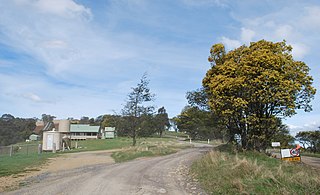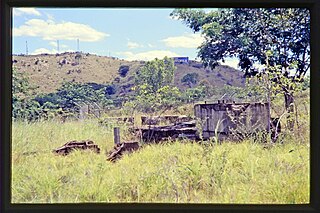
Frederick William Cuthbert (died 5 October 1948) [1] was a grocer and miner in Croydon, Queensland, Australia. He was known as the "Gold King of the North". [2]

Frederick William Cuthbert (died 5 October 1948) [1] was a grocer and miner in Croydon, Queensland, Australia. He was known as the "Gold King of the North". [2]
Born about 1855, Cuthbert was the son of a London policeman. [2]
Cuthbert arrived in Melbourne in 1876 with 3/6 in his pocket. He carried his swag from Melbourne to Glen Innes, New South Wales where he spent six years as a miner and storekeeper. While he was prospecting between Glen Innes and Grafton, he honed his skill at recognising gold-bearing country. [2]
From Grafton, Cuthbert went to the goldfields of Gympie. From there, he was part of the first goldrush in Croydon in 1885–1886, but it was a "duffer" (short-lived). Having visited Thursday Island, he decided to return to Croydon, walking 450 miles from Cooktown to do so. [2]
On his second visit, he struck gold on the Golden Gate reef, which produced £112,000 over 19 years. [2] He established the Content Mine in 1887. The mine remained under Cuthbert's proprietorship throughout its life without resorting to public investment. Cuthbert was the last of Croydon's influential mining men. He was known for his openness to new ideas such using the diamond drill to test his geological theories. His use of rock drilling machinery to make large, low-grade ore bodies pay through economies of scale was unusual in north Queensland. His personal qualities and business enterprises were important for the success of mining activities on the Croydon Goldfield. In September 1900, Cuthbert applied for a new lease for the Content Mine and commenced sinking a shaft striking the reef at 85m. He then spent over £10,000 on equipment and development work before he received any returns, something most companies would not have been prepared to do. However, Cuthbert believed in the mine's potential and was ultimately rewarded. [3]
Having sold his interests, eight years later Cuthbert met a friend on a Brisbane racecourse and was persuaded to invest in a mine at Misima Island in New Guinea. This was another success, and he sold out 81⁄2 years later for £75,000. [2]
Although wealthy, Cuthbert was not able to sit idle. He returned to Croydon, but he was unable to proceed due to World War II. He then moved to Georgetown where he lived with old friends Jack Bethel and his wife. [2]
On 25 October 1948, Cuthbert died aged 93 years at the home of his niece, Mrs J. Beyrer, at Wilston, Brisbane. [2] He was cremated at the Mount Thompson crematorium on 27 October. [4]

The Victorian gold rush was a period in the history of Victoria, Australia, approximately between 1851 and the late 1860s. It led to a period of extreme prosperity for the Australian colony and an influx of population growth and financial capital for Melbourne, which was dubbed "Marvellous Melbourne" as a result of the procurement of wealth.

Matlock is a rural locality in Victoria, Australia, located about 140 kilometres north-east of Melbourne, located within the Shires of Mansfield and Yarra Ranges local government areas. Matlock recorded a population of 7 at the 2021 census.

William Henry John Slee, FGS (1836–1907), was an Australian geologist, mines inspector, and mining warden.

During the Australian gold rushes, starting in 1851, significant numbers of workers moved from elsewhere in Australia and overseas to where gold had been discovered. Gold had been found several times before, but the colonial government of New South Wales had suppressed the news out of the fear that it would reduce the workforce and destabilise the economy.
James Frederick Porter (1855-1919) was an Australian engineer and mine manager of the Gippsland region of Victoria.
Thomas Frederic De Courcy Browne was an Irish-born Australian politician and journalist.

William Henry Browne, known as W. H. Browne or Billy Browne, was a gold miner and member of the Queensland Legislative Assembly.

Wenlock Goldfield is a heritage-listed mine in Archer River, Shire of Cook, Queensland, Australia. It was built from 1892 to 1950s. It is also known as Batavia Goldfield and Lower Camp (Wenlock). It was added to the Queensland Heritage Register on 3 March 2006.

Anglo Saxon Mine is a heritage-listed mining camp at Groganville, Shire of Mareeba, Queensland, Australia. It was built from 1886 to 1897. It is also known as Groganville Township and Limestone Cemetery. It was added to the Queensland Heritage Register on 3 October 2003.

ED Miles Mining Exchange is a heritage-listed commercial building at 65 Mosman Street, Charters Towers City, Charters Towers, Charters Towers Region, Queensland, Australia. It was designed by William George Smith junior, and built in 1887 by Ben Toll. It was added to the Queensland Heritage Register on 9 November 2012.

Day Dawn mine remains is a heritage-listed mine ruins at Paull Street, Charters Towers City, Charters Towers, Charters Towers Region, Queensland, Australia. It was built from 1891 to 1913. It was added to the Queensland Heritage Register on 29 April 2003.

Content Mine is a heritage-listed former mine at Gulf Developmental Road, Croydon, Shire of Croydon, Queensland, Australia. It was built from 1887 to 1918. It is also known as Content Block Mine. It was added to the Queensland Heritage Register on 4 July 2006.

Old Croydon Cemetery is a heritage-listed closed cemetery west of the Croydon railway station, Croydon, Shire of Croydon, Queensland, Australia. It was built from c. 1886 to 1889. It is also known as Croydon Cemetery. It was added to the Queensland Heritage Register on 25 October 2002.

Croydon Cemetery is a heritage-listed cemetery at Julia Creek Road, Croydon, Shire of Croydon, Queensland, Australia. It was opened c. 1889. It was added to the Queensland Heritage Register on 25 October 2002.

Station Creek Cemetery is a heritage-listed cemetery at Normanton Road, Croydon, Shire of Croydon, Queensland, Australia. It was opened c. 1899. It is also known as Golden Gate Cemetery. It was added to the Queensland Heritage Register on 25 October 2002.

Richmond Mine and Battery is a heritage-listed mine at Gulf Developmental Road, Croydon, Shire of Croydon, Queensland, Australia. It operated from 1886 to c. 1916. It was added to the Queensland Heritage Register on 28 July 2006.

Golden Gate Mining and Town Complex is a heritage-listed mining camp at Normanton Road, Croydon, Shire of Croydon, Queensland, Australia. It commenced in 1886. It is also known as Golden Gate Township, Croydon Consols Pump Shaft, Golden Gate No.10 North Mine, Golden Gate Cemetery, Croydon Consols Battery and Cyanide Plant, and Golden Gate Mine. It was added to the Queensland Heritage Register on 14 August 2009.

Ravenswood Mining Landscape and Chinese Settlement Area is a heritage-listed former mining town and archaeological site on the reserve bounded by School Street, Cemetery Road, Railway Street and Burdekin Falls Dam Road, Ravenswood, Charters Towers Region, Queensland, Australia. It was added to the Queensland Heritage Register on 14 October 2016.
Ian MorleyISO (1904–1989) was an Australian mining engineer and administrator, who advocated for safe mining practices and reforms for the Australian mining industry.

Chapel Street Bridge is a heritage-listed road bridge at Chapel Street, Ravenswood, Charters Towers Region, Queensland, Australia. It was built from 1895 to 1898. It was added to the Queensland Heritage Register on 29 November 2019.
![]() Media related to Frederick William Cuthbert at Wikimedia Commons
Media related to Frederick William Cuthbert at Wikimedia Commons